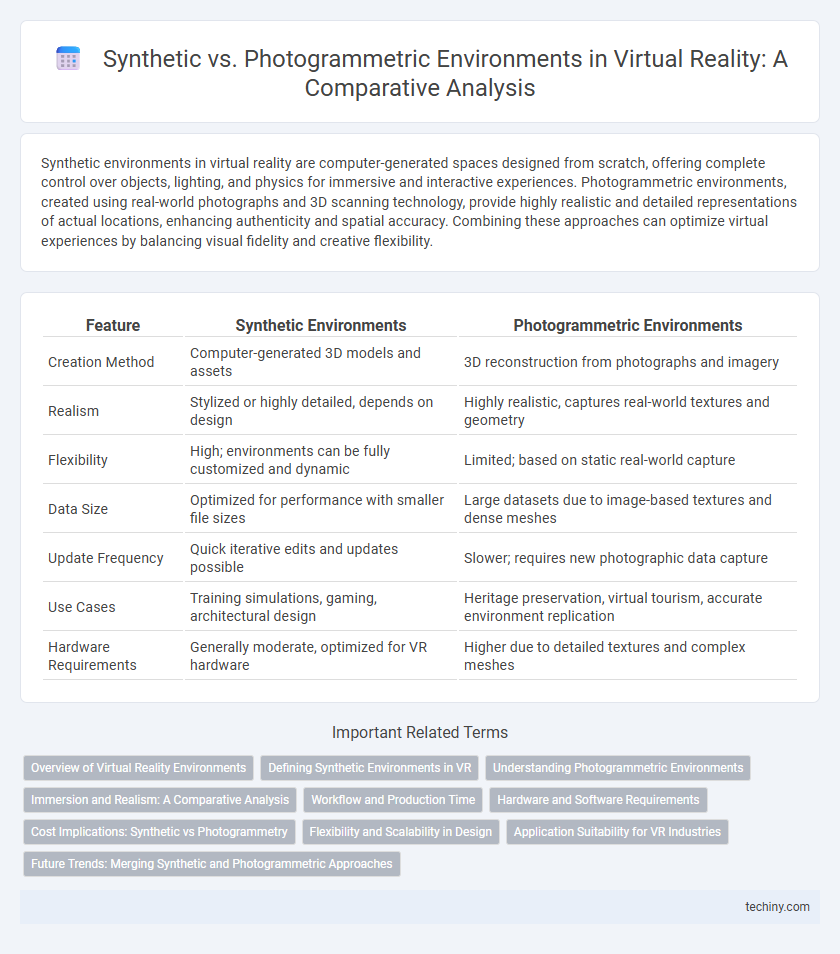Synthetic environments in virtual reality are computer-generated spaces designed from scratch, offering complete control over objects, lighting, and physics for immersive and interactive experiences. Photogrammetric environments, created using real-world photographs and 3D scanning technology, provide highly realistic and detailed representations of actual locations, enhancing authenticity and spatial accuracy. Combining these approaches can optimize virtual experiences by balancing visual fidelity and creative flexibility.
Table of Comparison
| Feature | Synthetic Environments | Photogrammetric Environments |
|---|---|---|
| Creation Method | Computer-generated 3D models and assets | 3D reconstruction from photographs and imagery |
| Realism | Stylized or highly detailed, depends on design | Highly realistic, captures real-world textures and geometry |
| Flexibility | High; environments can be fully customized and dynamic | Limited; based on static real-world capture |
| Data Size | Optimized for performance with smaller file sizes | Large datasets due to image-based textures and dense meshes |
| Update Frequency | Quick iterative edits and updates possible | Slower; requires new photographic data capture |
| Use Cases | Training simulations, gaming, architectural design | Heritage preservation, virtual tourism, accurate environment replication |
| Hardware Requirements | Generally moderate, optimized for VR hardware | Higher due to detailed textures and complex meshes |
Overview of Virtual Reality Environments
Virtual reality environments can be broadly categorized into synthetic and photogrammetric types, each offering unique immersive experiences. Synthetic environments are computer-generated, allowing for complete control over objects, lighting, and physics to create highly customizable and interactive virtual worlds. Photogrammetric environments, derived from real-world data captured through photography and scanning, provide photorealistic representations that enhance realism and spatial accuracy in VR applications.
Defining Synthetic Environments in VR
Synthetic environments in virtual reality are computer-generated 3D models created using graphics algorithms, offering complete control over spatial design and interactive elements. These environments enable precise manipulation of textures, lighting, and object behavior, providing immersive and customizable VR experiences. Unlike photogrammetric environments that rely on real-world image data, synthetic environments prioritize flexibility and scalability for diverse VR applications.
Understanding Photogrammetric Environments
Photogrammetric environments in virtual reality utilize high-resolution images to reconstruct real-world spaces with precise geometric and texture details, enhancing immersion and realism. These environments rely on photogrammetry techniques that process multiple overlapping photographs to generate accurate 3D models, capturing intricate surface details and natural lighting conditions. This approach surpasses synthetic environments in visual fidelity, providing users with authentic representations critical for applications like training, simulation, and cultural heritage preservation.
Immersion and Realism: A Comparative Analysis
Synthetic environments offer highly controllable and customizable virtual spaces, optimizing immersion through tailored interactive elements and dynamic scenarios. Photogrammetric environments provide unparalleled realism by utilizing real-world textures and geometries captured via high-resolution photography, enhancing user presence with authentic spatial details. Combining synthetic interactivity with photogrammetric accuracy creates a balanced VR experience, elevating both immersion and visual fidelity.
Workflow and Production Time
Synthetic environments in virtual reality rely on 3D modeling and texturing, enabling faster iteration and easier customization during workflow, often reducing production time significantly. Photogrammetric environments require extensive image capture and processing to generate detailed 3D reconstructions, resulting in longer production times due to data acquisition and cleanup. The trade-off between the two lies in synthetic environments offering streamlined production workflows, while photogrammetric environments provide high realism at the cost of extended development schedules.
Hardware and Software Requirements
Synthetic environments in virtual reality demand powerful hardware with high-performance GPUs and extensive CPU capabilities to render complex 3D models in real-time, relying on advanced software like Unity or Unreal Engine for procedural generation and dynamic interactions. Photogrammetric environments require specialized hardware such as high-resolution cameras and photogrammetry rigs for capturing detailed real-world textures and geometry, alongside software like Agisoft Metashape or RealityCapture to process and reconstruct accurate 3D models from images. Both approaches necessitate substantial storage and processing power, but synthetic environments prioritize real-time rendering optimization, whereas photogrammetric environments focus heavily on data acquisition and post-processing accuracy.
Cost Implications: Synthetic vs Photogrammetry
Synthetic environments typically demand higher upfront investment due to extensive 3D modeling and rendering processes, but offer greater flexibility and scalability for virtual reality projects. Photogrammetric environments, generated from real-world images, reduce initial modeling costs but involve significant expenses in data capture, processing, and storage, especially for large-scale scenes. Over time, synthetic solutions may prove more cost-effective for iterative development and complex interactive experiences, while photogrammetry excels in delivering realistic visuals with moderate budget constraints.
Flexibility and Scalability in Design
Synthetic environments in virtual reality offer superior flexibility and scalability in design, enabling creators to modify and expand digital worlds effortlessly through parametric modeling and procedural generation techniques. Photogrammetric environments, while delivering high-fidelity real-world textures and geometries, are limited by their reliance on captured data, making large-scale modifications and expansions more resource-intensive and less adaptable. Scalability in synthetic environments supports dynamic content integration and real-time updates, essential for immersive VR applications requiring continuous evolution and user interaction.
Application Suitability for VR Industries
Synthetic environments offer high customization and real-time interaction, making them ideal for training simulations in aerospace and military VR applications. Photogrammetric environments provide photorealistic accuracy, which enhances immersion in architectural visualization and cultural heritage preservation. VR industries select synthetic or photogrammetric environments based on the need for flexibility versus realism in user experience design.
Future Trends: Merging Synthetic and Photogrammetric Approaches
Future trends in virtual reality emphasize the integration of synthetic environments with photogrammetric environments to leverage the precision of real-world data and the flexibility of computer-generated models. This hybrid approach enhances immersive experiences by combining high-resolution textures from photogrammetry with dynamic, customizable elements of synthetic environments. Advancements in AI-driven reconstruction and real-time rendering technologies are accelerating the seamless merging of these methods, enabling more realistic and interactive VR applications across gaming, simulation, and training sectors.
Synthetic environments vs Photogrammetric environments Infographic

 techiny.com
techiny.com